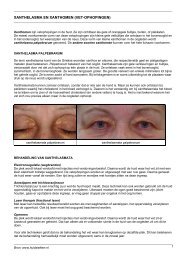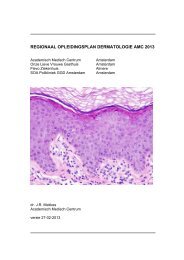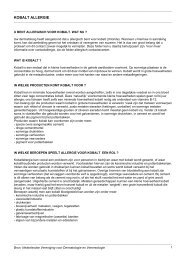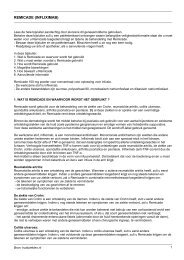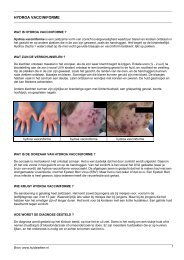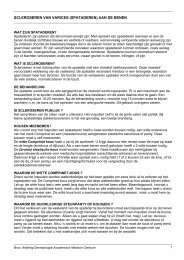Guidelines of care for the management of psoriasis ... - Huidziekten.nl
Guidelines of care for the management of psoriasis ... - Huidziekten.nl
Guidelines of care for the management of psoriasis ... - Huidziekten.nl
Create successful ePaper yourself
Turn your PDF publications into a flip-book with our unique Google optimized e-Paper software.
852 Gottlieb et al<br />
METHOD<br />
A work group <strong>of</strong> recognized experts was convened<br />
to determine <strong>the</strong> audience <strong>for</strong> <strong>the</strong> guideline,<br />
define <strong>the</strong> scope <strong>of</strong> <strong>the</strong> guideline, and identify<br />
clinical questions to structure <strong>the</strong> primary issues in<br />
diagnosis and <strong>management</strong> (see Table I in Section 1).<br />
Work group members were asked to complete a<br />
disclosure <strong>of</strong> commercial support.<br />
An evidence-based model was used and evidence<br />
was obtained using a search <strong>of</strong> <strong>the</strong> MEDLINE database<br />
spanning <strong>the</strong> years 1990 through 2007. O<strong>nl</strong>y<br />
English-language publications were reviewed.<br />
The available evidence was evaluated using<br />
a unified system called <strong>the</strong> Strength <strong>of</strong> Recommendation<br />
Taxonomy developed by editors <strong>of</strong> <strong>the</strong> US<br />
family medicine and primary <strong>care</strong> journals (ie, American<br />
Family Physician, Family Medicine, Journal <strong>of</strong><br />
Family Practice, and BMJ USA). This strategy was<br />
supported by a decision <strong>of</strong> <strong>the</strong> Clinical <strong>Guidelines</strong><br />
Task Force in 2005 with some minor modifications<br />
<strong>for</strong> a consistent approach to rating <strong>the</strong> strength <strong>of</strong> <strong>the</strong><br />
evidence <strong>of</strong> scientific studies. 1 Evidence was graded<br />
using a 3-point scale based on <strong>the</strong> quality <strong>of</strong> methodology<br />
as follows:<br />
I. Good-quality patient-oriented evidence.<br />
II. Limited-quality patient-oriented evidence.<br />
III. O<strong>the</strong>r evidence including consensus guidelines,<br />
opinion, or case studies.<br />
Clinical recommendations were developed on <strong>the</strong><br />
best available evidence tabled in <strong>the</strong> guideline.<br />
These are ranked as follows:<br />
A. Recommendation based on consistent and goodquality<br />
patient-oriented evidence.<br />
B. Recommendation based on inconsistent or<br />
limited-quality patient-oriented evidence.<br />
C. Recommendation based on consensus, opinion,<br />
or case studies.<br />
This guideline has been developed in accordance<br />
with <strong>the</strong> American Academy <strong>of</strong> Dermatology<br />
(AAD)/AAD Association ‘‘Administrative Regulations<br />
<strong>for</strong> Evidence-based Clinical Practice <strong>Guidelines</strong>,’’<br />
which include <strong>the</strong> opportunity <strong>for</strong> review and comment<br />
by <strong>the</strong> entire AAD membership and final review<br />
and approval by <strong>the</strong> AAD Board <strong>of</strong> Directors.<br />
INTRODUCTION<br />
PsA is an inflammatory seronegative spondyloarthropathy<br />
associated with <strong>psoriasis</strong>. The exact<br />
proportion <strong>of</strong> patients with <strong>psoriasis</strong> who will develop<br />
PsA is an area <strong>of</strong> significant controversy with<br />
studies demonstrating a range from as low as 6% to as<br />
JAM ACAD DERMATOL<br />
MAY 2008<br />
high as 42% <strong>of</strong> patients with <strong>psoriasis</strong>. The prevalence<br />
<strong>of</strong> PsA in <strong>the</strong> general population <strong>of</strong> <strong>the</strong> United<br />
States has been estimated to be between 0.1% to<br />
0.25%. 2 In a recent large clinical trial with more than<br />
1000 patients, 84% <strong>of</strong> patients with PsA had cutaneous<br />
manifestations <strong>for</strong> an average <strong>of</strong> 12 years be<strong>for</strong>e<br />
<strong>the</strong> onset <strong>of</strong> PsA. 3<br />
Dermatologists are strongly encouraged to actively<br />
seek signs and symptoms <strong>of</strong> PsA at each visit. If<br />
PsA is diagnosed, treatment should be initiated to<br />
alleviate signs and symptoms <strong>of</strong> PsA, inhibit structural<br />
damage, and maximize quality <strong>of</strong> life (QOL).<br />
Dermatologists uncom<strong>for</strong>table or untrained in evaluating<br />
or treating patients with PsA should refer to<br />
rheumatologists.<br />
PsA can develop at any time including childhood,<br />
but <strong>for</strong> most it appears between <strong>the</strong> ages <strong>of</strong> 30 and 50<br />
years. PsA affects men and women equally. PsA is<br />
characterized by stiffness, pain, swelling, and tenderness<br />
<strong>of</strong> <strong>the</strong> joints and surrounding ligaments and<br />
tendons (dactylitis and en<strong>the</strong>sitis). The en<strong>the</strong>sis is <strong>the</strong><br />
anatomic location where tendon, ligament, or joint<br />
capsule fibers insert into <strong>the</strong> bone. En<strong>the</strong>sitis may<br />
occur at any such site, although common locations<br />
include <strong>the</strong> insertion sites <strong>of</strong> <strong>the</strong> plantar fascia, <strong>the</strong><br />
Achilles’ tendons, and ligamentous attachments to<br />
<strong>the</strong> ribs, spine, and pelvis. Dactylitis, or ‘‘sausage<br />
digit,’’ is a combination <strong>of</strong> en<strong>the</strong>sitis <strong>of</strong> <strong>the</strong> tendons<br />
and ligaments and synovitis involving a whole digit.<br />
Symptoms <strong>of</strong> PsA can range from mild to very<br />
severe. The severity <strong>of</strong> <strong>the</strong> skin disease and <strong>the</strong> arthritis<br />
usually do not correlate with each o<strong>the</strong>r. Nail disease is<br />
commo<strong>nl</strong>y found in patients with PsA especially those<br />
with distal interphalangeal (DIP) joint involvement.<br />
PsA may start slowly with mild symptoms, and, on<br />
occasion, may be preceded by a joint injury.<br />
The course <strong>of</strong> PsA is variable and unpredictable<br />
ranging from mild and nondestructive to a severe,<br />
debilitating, erosive arthropathy. Erosive and de<strong>for</strong>ming<br />
arthritis occurs in 40% to 60% <strong>of</strong> patients<br />
with PsA based on data from rheumatology referral<br />
centers and may be progressive as early as within <strong>the</strong><br />
first year <strong>of</strong> diagnosis. Studies from <strong>the</strong> general<br />
population indicate that PsA may have a milder<br />
course and that it is not associated with excess<br />
mortality. 4 Data on <strong>the</strong> clinical course <strong>of</strong> PsA in <strong>the</strong><br />
dermatology setting are not currently available.<br />
Flares and remissions usually characterize <strong>the</strong> course<br />
<strong>of</strong> PsA. Left untreated, patients with PsA can have<br />
persistent inflammation, progressive joint damage,<br />
severe physical limitations, disability, and increased<br />
mortality.<br />
The spectrum <strong>of</strong> joint inflammation in PsA is great,<br />
ranging from axial to peripheral disease, synovial<br />
and adjacent s<strong>of</strong>t tissue inflammation, en<strong>the</strong>sitis,



